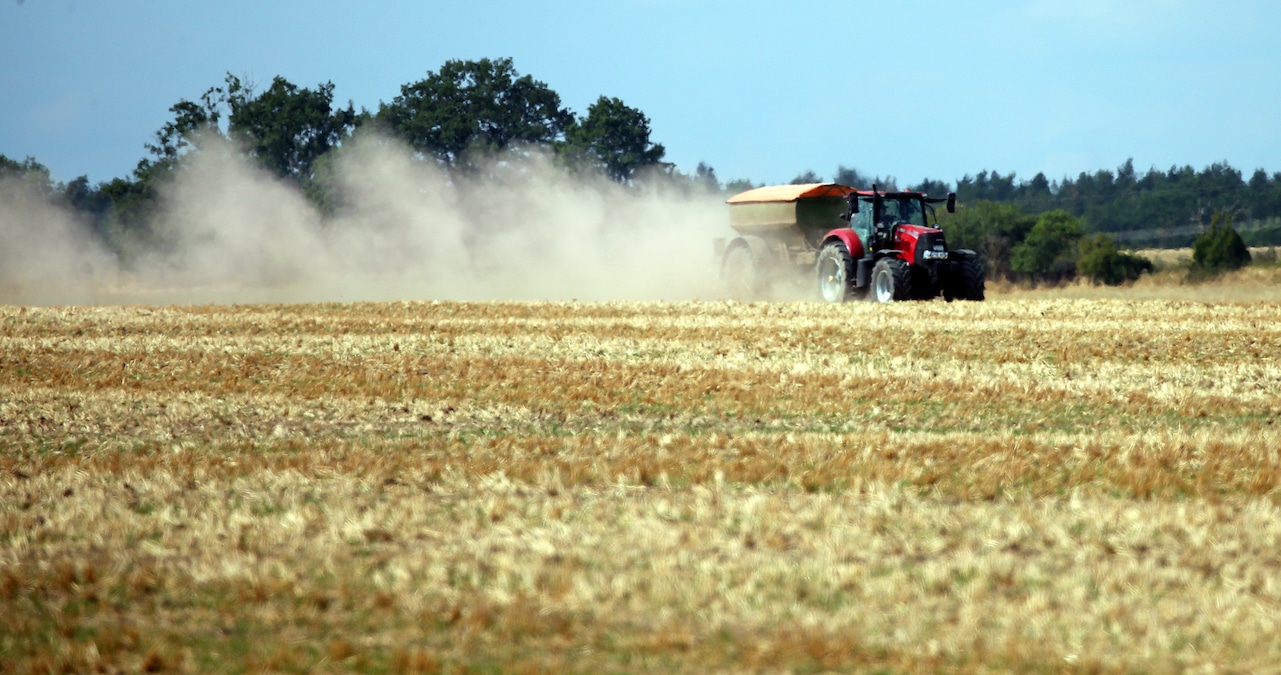Ecowatch
Fertilizing Fields With Sewage Sludge Releases More Microplastics Into the Air Than Previously Believed, Study Finds

A farmer spreads fertilizer on a grain field near Berlin, Germany. Wolfgang Kumm / picture alliance via Getty Images
 Why you can trust us
Why you can trust us
Founded in 2005 as an Ohio-based environmental newspaper, EcoWatch is a digital platform dedicated to publishing quality, science-based content on environmental issues, causes, and solutions.
Microplastics are tiny plastic particles from textiles and other sources that have broken down into smaller and smaller pieces until they are less than five millimeters in length. They have been found all over the world, from sediments in the deep ocean to Arctic snow.
Scientists have found that microplastics are being released though natural fertilizers from treated sewage sludge deposited onto agricultural fields, as more plastic particles get picked up by the wind than was previously believed, a press release from the American Chemical Society (ACS) said.
“Land application of wastewater biosolids on agricultural soils is suggested as a sustainable pathway to support the circular economy; however, this practice often enriches microplastics and associated contaminants in topsoil,” the authors of the small-scale study wrote. “Analyzing wind-borne sediments collected from wind tunnel experiments on biosolid-applied agricultural fields, we show enrichment of microplastics in wind-blown sediments.”
The researchers found that microplastics are picked up from fields by wind more easily than dust particles of a similar size.
“[T]he combined effects of the low density of microplastics and weakened wet-bonding interparticle forces between microplastics and soil particles lower their threshold velocity, the minimum wind velocity necessary for wind erosion to occur. Our calculations indicate that microplastics could be emitted at wind speeds lower than the characteristic threshold of background soil,” the researchers wrote in the study.
The study, “Preferential Emission of Microplastics from Biosolid-Applied Agricultural Soils: Field Evidence and Theoretical Framework,” was published in the journal Environmental Science & Technology Letters.
Microplastics have increasingly been found in water supplies and the human body, as well as in wastewater and sewage, ACS said. Sewage solids can be treated and turned into “biosolids” that can be used as an agricultural fertilizer that is both renewable and natural.
U.S. Environmental Protection Agency estimates are that more than 2.2 million tons of biosolids are applied to land annually — that’s approximately half the total collected in wastewater treatment plants. This gives microplastics found in biosolids the opportunity to reenter the natural environment. The tiny plastics could be carrying wastewater pollutants on them, making them dangerous to inhale.
The research team looked at wind-blown sediments containing airborne microplastics that had been gathered on two plots of land treated with biosolids in Washington state. The researchers found that the sediments had higher microplastics concentrations than the source soil or biosolids.
Because the microplastics are not as dense or “sticky” as soil minerals like quartz, they aren’t as easily trapped by moisture. This means they can more readily be swept up by breezes that are not strong enough to blow dust into the air.
“Analyzing the windspeed distribution for 3 months of wind events over a bare soil surface, we showed that more than 84% of the wind events exceed the threshold velocity of microplastics of size 150 μm, while only 23% of the wind events exceed the threshold velocity of the background soil,” the researchers wrote.
The research team said earlier models didn’t consider unique properties of microplastics like the “sticky effect” when making estimates of emissions from fields treated with biosolids. Because of this, the older models likely miscalculated the true amount of microplastics released into the air.
The team’s calculations indicated that plastic particles may be blown from barren agricultural fields almost 2.5 times more frequently by wind events than previously thought.
“Thus, current models for fugitive dust emissions may underestimate the microplastic emission potential of biosolid-amended soils,” the study said.
Subscribe to get exclusive updates in our daily newsletter!
By signing up, you agree to the Terms of Use and Privacy Policy & to receive electronic communications from EcoWatch Media Group, which may include marketing promotions, advertisements and sponsored content.
Source
Disclaimer: No copyright infringement intended. All rights and credits reserved to respective owner(s).












